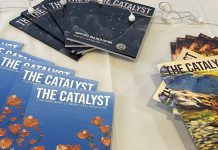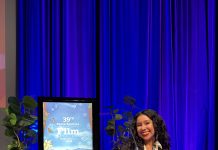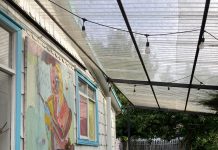Hannah Maerowitz
Staff Writer
The raccoon was not the only majestic wildlife UCSB students were able to see roaming over Deltopia weekend. On Saturday, April 7, Gauchos crowded around three American alligators, a Eurasian eagle owl, and a kinkajou, among other exotic animals, brought by the Conservation Ambassadors in the name of wildlife education.
Such wildlife diversity is far from intrinsic to Isla Vista, although kinkajous are a close relative of the racoon. “The animals here today are all non-releasable animals,” said Melanie Angeles, COO of Conservation Ambassadors, in an interview with The Bottom Line. “They have injuries that make it difficult for them to functionally exist in the wild, so we care for them in captivity.”
Angeles went on to describe that the injuries sustained by these animals are primarily caused by humans.
“Wildlife regulations vary by state. There are very few federal wildlife laws that protect animals, which means that people can go to states where wildlife regulations are more lax and purchase an exotic animal. They often have a sensationalized notion of these animals and once they realize their fantasy is just a fantasy, they often give it away or abandon it.”
Angeles and her team at Conservation Ambassadors turn these animals into ambassador animals, taking them to schools, where they educate students about animals in a setting where they can interact with them.
At the event, eight different animal ambassadors were showcased: a spider monkey, a kinkajou, an Eastern screech owl, a Eurasian eagle owl, an African crested porcupine, and three American alligators at varying stages of maturity.
When the presenters called for a volunteer, one bold UCSB student even held all three alligators—including one that weighed approximately 100 pounds.
The stories Angeles and her coworkers told about how they acquired the animals illustrated how important knowledge and consideration are in the process of adopting a pet, especially when it comes to exotic animals that are not domesticated.
For example, the spider monkey was found in a garbage dumpster in Los Angeles, while one of the American alligators was found in the Sacramento River Delta.
“One of the reasons we present at schools is to caution students about sensationalizing animals like these and going to extreme measures to adopt them as pets. Most of them are meant to be in the wild and behave as such,” said Angeles, after sharing how the kinkajou had his canine teeth and claws taken out by an owner that was likely attempting to make him more tame.
The kinkajou was not the only animal whose ability to live in the wild was severely compromised by their previous owners’ stints of exotic pet ownership. The spider monkey suffered from a bone disease caused by undernourishment, and all three of the American alligators are smaller than average for their respective ages for the same reason.
Despite the carelessness these animals suffered at the hands of their previous owners, they were exceedingly calm as students photographed them and even touched them, especially in the case of the alligators.
The Hub and RHA partnered to bring this successful and engaging event to students during Deltopia weekend.









Definitely, what a fantastic website and enlightening posts,
I surely will bookmark your website.Have an awsome day!
Comments are closed.